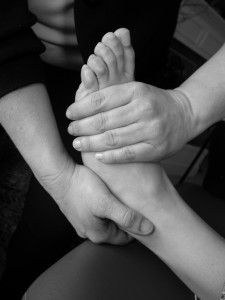What is Trigger Finger and How is it Diagnosed?
Trigger finger, called stenosing tenosynovitis by doctors, is a condition where the finger tends to get locked in place when you are bending it toward the palm. Most of the time, your family doctor will examine you and note the problematic symptoms. This condition is more common among people with rheumatoid arthritis or diabetes. The doctor usually refers you to an orthopedic hand specialist when the finger gets stuck or clicks and is not able to straighten.
The symptoms of trigger finger occur without injury most of the time, or they may follow a period of heavy hand usage. A tender lump can develop in your palm and there may be swelling. The main symptom is inability to straighten the finger without pain and the finger will catch or pop. The stiffness of trigger finger tends to worsen after periods of inactivity and many find that it is worse in the mornings.
Often times, trigger fingers can be treated with a steroid injection in the office. If the finger continues to catch or lock after a steroid injection, the treatment for this condition becomes surgery to open up the flexor tendon sheath in order to eliminate the catching or locking.
What Do I Need to Do Before Trigger Finger Release Surgery?
Before you undergo this procedure, your orthopedic hand specialist will discuss with you exactly what will happen before, during, and after the procedure. You can prepare yourself by asking questions to help you be well informed so you can go ahead with the consent for surgery and sign the necessary forms.
The operation is done under local or regional anesthesia, which means you will be awake and alert during trigger finger release surgery. Your hand will be totally numb, however, allowing your surgeon to operate painlessly.
What is Involved with Surgery?
Once the anesthetic has taken effect, your orthopedic hand specialist will make a 2cm incision into the palm of your hand so he or she can get to the tendon. The surgeon then will release the tendon by making a small incision in the first annular pulley of the tendon sheath. Once this has occurred, you may be asked to move your fingers and to make a fist.
Don’t worry, because of the anesthesia, this won’t hurt. Once the doctor is sure the tendon is properly released, he will close the incision and cover the wound area with a bandage.
What Can I Expect After the Trigger Finger Release Surgery?
It may take several hours before the feeling comes back in your hand so you must be careful not to bump or knock the area. You may need to take pain medication for a few days following this operation as well.
If you have general anesthesia, you will need to rest in a recovery room until the effects of it have worn off. The nurse or doctor will give you follow-up care advice and a follow-up appointment. You will need to keep your dressing and stitches clean and dry for around ten days and then they will be removed. It usually takes about three or four weeks to fully recover from trigger finger release surgery, so it is important that you follow your orthopedic specialist’s advice during this time.

 Physical therapy uses non-invasive and non-medical techniques and tools to help you improve total body function. Our physical therapist focuses on relief of pain, promotion of healing, restoration of function and movement, and adaption and facilitation associated with the injury involved. PT also focuses on body mechanics training, wellness, and fitness so you can improve your quality of life. Our physical therapist uses exercise, cold therapy, heat treatments, electricity, and therapeutic massage to achieve the goals of restoring maximum functioning to each individual patient.
Physical therapy uses non-invasive and non-medical techniques and tools to help you improve total body function. Our physical therapist focuses on relief of pain, promotion of healing, restoration of function and movement, and adaption and facilitation associated with the injury involved. PT also focuses on body mechanics training, wellness, and fitness so you can improve your quality of life. Our physical therapist uses exercise, cold therapy, heat treatments, electricity, and therapeutic massage to achieve the goals of restoring maximum functioning to each individual patient.  Many Americans suffer rotator cuff tears and they are a common cause of pain and disability. When you tear your rotator cuff, you weaken your entire shoulder making daily activities more difficult. Just raising your hand up to comb your hair could cause serious pain. Read on to find out what makes up the rotator cuff, who is at risk for this type of injury, what are the symptoms of a tear, and how a rotator cuff is treated.
Many Americans suffer rotator cuff tears and they are a common cause of pain and disability. When you tear your rotator cuff, you weaken your entire shoulder making daily activities more difficult. Just raising your hand up to comb your hair could cause serious pain. Read on to find out what makes up the rotator cuff, who is at risk for this type of injury, what are the symptoms of a tear, and how a rotator cuff is treated. 